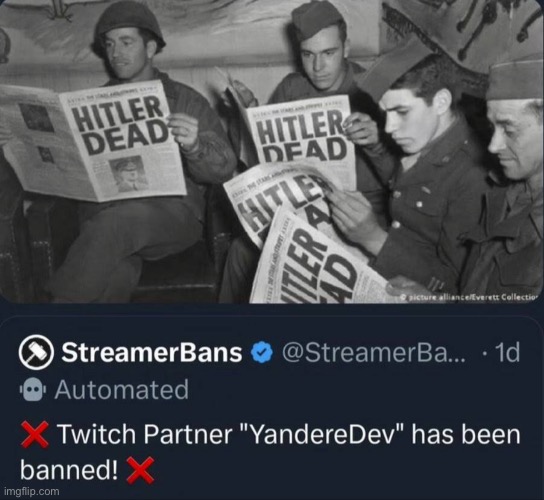The Hammer Falls: Understanding Bans in the World of Streaming
Introduction
The world of live streaming has exploded in popularity. Platforms like Twitch, YouTube Gaming, and Facebook Gaming have become modern-day coliseums, where streamers battle for viewers, subscribers, and ultimately, a livelihood. But with great power comes great responsibility—and the potential for a swift and decisive punishment: the ban. A ban, whether temporary or permanent, can be devastating for a streamer, impacting their income, reputation, and connection with their community. This article delves into the complex world of streamer bans, exploring the reasons behind them, the impact they have, and the ongoing debates surrounding their enforcement.
What is a Streamer Ban?
At its core, a streamer ban is the removal of a streamer’s ability to broadcast on a specific platform. This can range from a short suspension of a few days to a permanent removal from the platform, effectively ending their streaming career on that site.
- Temporary Bans: These are typically issued for less severe violations of the platform’s terms of service. The length can vary, ranging from a few hours to several weeks.
- Permanent Bans: The most severe penalty, permanent bans are usually reserved for egregious violations or repeat offenses. They often result in the streamer’s channel being removed entirely.
Why Are Streamers Banned? Common Offenses
Streaming platforms have community guidelines and terms of service designed to maintain a safe and enjoyable environment for all users. Violating these rules can lead to a ban. Here are some of the most common reasons:
- Hate Speech and Discrimination: This includes any content that promotes violence, incites hatred, or promotes discrimination based on race, ethnicity, religion, gender, sexual orientation, disability, or other protected characteristics. Platforms have become increasingly strict on this, especially after a rise in targeted harassment campaigns.
- Harassment and Bullying: Targeting other users with abusive or threatening language, or engaging in behavior that creates a hostile environment, is strictly prohibited.
- Copyright Infringement: Streaming copyrighted material (e.g., movies, TV shows, music) without permission can lead to a DMCA takedown request and a ban.
- Sexually Suggestive Content or Nudity: Platforms typically have strict rules against sexually explicit content, nudity, or activities.
- Violence and Graphic Content: Showing real-world violence, gore, or content that glorifies violence can result in a ban.
- Sharing Personal Information (Doxing): Revealing someone’s personal information without their consent is a serious violation of privacy and can lead to a ban.
- Cheating or Exploiting Games: In the gaming world, cheating or exploiting glitches in games can result in a ban from the platform, especially if it provides an unfair advantage.
- Ban Evasion: Attempting to circumvent a ban by creating a new account or using alternative methods is strictly prohibited and can lead to further penalties.
The Impact of a Ban
The consequences of a streamer ban can be significant:
- Financial Loss: Streaming is often a primary source of income for streamers. A ban can halt their earnings from subscriptions, donations, sponsorships, and advertisements.
- Reputational Damage: Bans can tarnish a streamer’s reputation, making it difficult to regain the trust of their audience and attract new viewers.
- Loss of Community: Streamers invest time and effort in building a community around their channel. A ban can disrupt this community, as viewers may move on to other streamers or platforms.
- Mental Health: The stress and anxiety associated with a ban can take a toll on a streamer’s mental health, especially if they rely on streaming for their livelihood and social connection.
Controversies and Debates
Streamer bans are not without controversy. Here are some of the ongoing debates:
- Inconsistent Enforcement: Critics argue that bans are often inconsistently enforced, with some streamers receiving harsher penalties than others for similar offenses. This can lead to accusations of bias or favoritism.
- Transparency: Platforms are often criticized for a lack of transparency regarding the reasons for bans and the appeals process. Streamers may be left in the dark about why they were banned and how to get their account reinstated.
- Freedom of Speech: Some argue that bans infringe on streamers’ freedom of speech, especially when the content in question is considered controversial but not explicitly illegal. However, platforms maintain that they have the right to set their own rules and standards for content.
- Rehabilitation vs. Punishment: There is debate over whether platforms should focus more on rehabilitation and education for streamers who violate the rules, rather than simply issuing bans. Some suggest implementing warning systems or mandatory training programs.
Recent Trends and Statistics
While specific data on streamer bans is often kept confidential by the platforms, here are some general trends and insights:
- Increased Scrutiny: In recent years, platforms have become more proactive in enforcing their community guidelines, leading to a rise in the number of bans issued. This is partly due to increased pressure from advertisers and the public to address issues like hate speech and harassment.
- Focus on Mental Health: Some platforms are beginning to offer resources and support for streamers who are struggling with mental health issues, recognizing the unique challenges of the profession.
- Appeals Processes: Most platforms have an appeals process for streamers who believe they have been unfairly banned. However, the success rate of appeals can vary widely.
Conclusion
Streamer bans are a complex issue with significant consequences for both streamers and the platforms they use. While bans are necessary to maintain a safe and enjoyable environment, it’s crucial that they are enforced fairly, transparently, and consistently. As the streaming industry continues to evolve, platforms will need to adapt their policies and practices to address the challenges and controversies surrounding streamer bans. A balanced approach that prioritizes both community safety and streamer rights is essential for the long-term health and sustainability of the streaming ecosystem.

